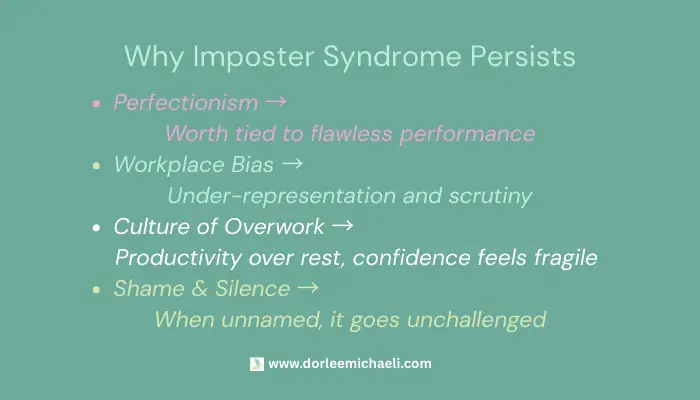
Imposter syndrome explained simply: it’s the persistent belief that your success is undeserved, even when the evidence clearly shows otherwise.
In this post, you’ll find imposter syndrome explained in simple, practical terms.
You’ve done the work. You’ve earned the degree, delivered the project, supported the team. On paper, the evidence is clear: you’re capable, accomplished, and respected.
So why do you still feel like a fraud?
That gnawing voice: “Any day now, they’ll find out I don’t really belong,” is the hallmark of what psychologists Pauline Rose Clance and Suzanne Imes first described in 1978 as the “Impostor Phenomenon,” now widely known as imposter syndrome (Azab, 2023).
When you see imposter syndrome explained this way, it’s clear the issue isn’t a lack of competence; it’s the mind’s way of protecting you from the vulnerability of being seen.
More than 40 years after Clance and Imes’ groundbreaking research, imposter syndrome remains a quiet struggle for millions of high-achieving women. And while the term gets tossed around casually, the reality is both more complex and more hopeful than most headlines suggest.
This post will explore the psychological roots of imposter syndrome, why it persists despite achievements, and evidence-based therapeutic approaches that can help you move from self-doubt to self-trust.
the origins of imposter syndrome
The Study That Changed Everything
In 1978, psychologists Pauline Clance and Suzanne Imes published a study of 150 highly successful women. These included women with advanced degrees, leadership roles, and strong academic records.
Despite clear evidence of their competence, many described themselves as frauds, convinced they had fooled others into overestimating their abilities. This was not humility.
These women genuinely believed their success was due to luck, timing, or being in the right place at the right time.
When they were praised, they dismissed it.
When they succeeded, they felt relief instead of pride.
Beyond the Original Study
Over time, research has confirmed that these “imposter” feelings are not limited to women in academia. They show up across diverse groups, including men, entrepreneurs, and people in creative fields. Still, the weight can feel particularly heavy for women in male-dominated professions like tech, finance, and healthcare, where bias and underrepresentation reinforce self-doubt.
Clance later developed the Clance Impostor Phenomenon Scale. This measure is still used today in research and clinical practice, underscoring that these feelings are both measurable and widespread. This helps explain why those old survival patterns still show up today.
When imposter syndrome is explained through a trauma-informed lens, patterns like overpreparing, perfectionism, and people-pleasing start to make sense because they’re old safety strategies, not flaws.

WHY IT PERSISTS
Even decades later, imposter syndrome continues to thrive, particularly for women in demanding fields. Why?
Perfectionism
Many quiet achievers grow up praised for being the “good student” or the “responsible one.” Worth becomes tied to flawless performance. As adults, any mistake feels like proof of inadequacy.Workplace Bias
Women, especially women of color and first-generation professionals, often face higher scrutiny and fewer opportunities for mentorship. Without role models who “look like them,” it’s easy to assume success is a fluke rather than proof of belonging.The Culture of Overwork
In fields like tech, finance, and healthcare, constant productivity is glorified. Rest feels undeserved, and confidence fragile. This double standard of being endlessly competent, endlessly kind, and endlessly available, makes it harder to claim success without guilt.Shame and Silence
Because imposter feelings thrive in secrecy, women rarely voice them. Without naming the pattern, it remains unchallenged and the cycle continues.

Quiet Achievers and Imposter Feelings
Quiet achievers may be especially vulnerable because they don’t always fit the cultural mold of what a “leader” should look like. In many professional settings, charisma and visibility are rewarded more quickly than reflection and depth.
For someone whose natural style is thoughtful, empathetic, or collaborative, this can spark the inner conflict of: “Maybe I don’t deserve this role because I’m not outspoken enough.”
The reality is that organizations need both styles of leadership. Quiet leadership brings balance, careful listening, and insight, qualities that are just as valuable as visibility and decisiveness.
The challenge is that these strengths often go unrecognized, leaving quiet achievers more prone to dismiss their worth.
Therapy can help reframe these traits, turning what once felt like liabilities into deeply valuable contributions.
The Five Patterns of Imposter Syndrome
These pressures often show up in recognizable patterns of thinking, described by psychologist Valerie Young, EdD. Each reflects a different survival strategy, but all lead to the same belief: “I’m not enough.”
-
The Perfectionist: A woman in finance who reviews a report ten times before sending it, convinced one error will ruin her career.
-
The Soloist: A physician who refuses to ask colleagues for input, believing she must handle every decision alone.
-
The Expert: A tech lead who won’t apply for a role until she’s mastered every software tool, even if she’s already more qualified than her peers.
-
The Natural Genius: A student who feels like a fraud if she needs extra time to learn, believing “smart people” shouldn’t struggle.
-
The Superwoman Pattern: A mother who believes she must excel at work, parenting, and friendships simultaneously while keeping everyone else steady. Any shortcoming proves she’s “fake.”
Naming these patterns is often the first step toward loosening their grip.
Imposter Syndrome Isn’t Just “Lack of Confidence”
One of the biggest misconceptions about imposter syndrome is that it’s simply about low confidence. If that were true, a pep talk or positive thinking would solve it. But if you’ve tried those, you know they rarely help for long.
At its core, imposter syndrome is not a personality flaw. It’s a learned survival pattern. Early experiences, cultural pressures, and workplace dynamics reinforce self-doubt until it feels automatic.
That’s why the work of Brené Brown, PhD, on shame and vulnerability is so powerful here. Brown reminds us that shame thrives in silence and secrecy. When we speak about these patterns openly, they lose some of their grip.
A Therapist’s Perspective: Rewiring Imposter Patterns
From a therapeutic standpoint, imposter feelings are the nervous system’s way of staying on high alert: “If I never feel safe in my success, maybe I won’t be caught off guard when something goes wrong.”
But living in this constant state of vigilance is exhausting. It narrows your window of tolerance, making joy, rest, and creativity harder to access.
This is where approaches like EMDR therapy can be helpful. EMDR doesn’t erase memories but helps the brain reprocess old experiences so they no longer trigger the same intense shame or fear. Combined with psychoanalytic exploration and self-compassion practices, therapy offers a way to gradually rewire imposter patterns.
As Norman Doidge’s research on neuroplasticity shows, repetition is key. Each time you practice a new response, you are strengthening a new pathway. This might mean pausing instead of spiraling or saying “thank you” instead of dismissing praise.
Hope Without Hype
Let’s be clear: therapy does not make imposter syndrome disappear overnight. These patterns were built over years and require patience to unwind.
But hope lies in the fact that they are not permanent. Your brain can change. Your inner critic can soften. Boundaries with yourself and others can help you step into a steadier sense of self.
Healing imposter feelings is not about becoming someone you’re not. It’s about reclaiming who you already are.
If you’ve ever felt like your accomplishments don’t count or that you’re one mistake away from being exposed, know this: you’re not alone, and you’re not broken.
Imposter syndrome explained simply; it’s a common, understandable response to the pressures of achievement, perfectionism, and bias. But it doesn’t have to run your life.
Through therapy, it’s possible to replace old patterns with new ones: patterns of self-trust, self-compassion, and confidence rooted in reality.
For some clients, especially high-achievers who want focused time to work through these patterns, I offer EMDR Therapy Intensives – structured sessions that create space for deeper healing without weekly scheduling pressure.
This article is Part 1 of my Imposter Syndrome Series. Over the next several posts, we’ll explore the hidden patterns that keep high-achieving women doubting their own success, and the practical ways to begin shifting them. Next up: The Perfectionist’s Dilemma: Success Without Satisfaction, one of the most common ways imposter syndrome shows up.
👉 For more articles in the series, visit the Imposter Syndrome archive.
If you are a quiet, high-achieving woman ready to loosen the grip of imposter feelings, I’d be honored to support you in that process.
Frequently Asked Questions About Imposter Syndrome
As a therapist, I frequently encounter questions about imposter syndrome. Here are the most common ones I hear, along with answers that many clients find helpful.
Q1: What is imposter syndrome?
Imposter syndrome is the persistent belief that your success is undeserved or due to luck, despite clear evidence of your competence. Rather than reflecting actual ability, it’s a learned pattern that often develops as a protective response to early experiences.
Q2: Is imposter syndrome the same as low confidence?
No. While ordinary self-doubt typically diminishes with experience, imposter feelings persist regardless of achievements. Imposter syndrome stems from deeper psychological roots including perfectionism, internalized messages from childhood, and heightened stress responses.
Q3: Who experiences imposter syndrome?
Originally identified in 1978 among high-achieving women, imposter syndrome is now recognized across all genders, professions, and cultures. It’s particularly prevalent in competitive or male-dominated fields like technology, finance, and healthcare, where systemic bias and high-pressure environments can amplify self-doubt.
Q4: How do I know if I have imposter syndrome?
Common indicators include deflecting compliments, over-preparing to avoid potential mistakes, attributing success to external factors like luck, and persistent fear of being “found out.” Recognizing these patterns is often the first step toward addressing them.
Q5: Can imposter syndrome be overcome?
Yes. While imposter feelings may resurface during transitions or new challenges, they don’t have to dictate your decisions. Treatment approaches include cognitive-behavioral therapy, self-compassion practices, and trauma-informed therapies like EMDR when early experiences contribute to the pattern.
References
Clance, P. R., & Imes, S. A. (1978). The impostor phenomenon in high achieving women: Dynamics and therapeutic intervention. Psychotherapy: Theory, Research & Practice, 15(3), 241–247. https://doi.org/10.1037/h0086006
Young, V. (2011). The secret thoughts of successful women: Why capable people suffer from the impostor syndrome and how to thrive in spite of it. New York, NY: Crown Business.
Brown, B. (2010). The gifts of imperfection: Let go of who you think you’re supposed to be and embrace who you are. Center City, MN: Hazelden Publishing.
Azab, M. (2023, August 15). The history of imposter syndrome. Psychology Today. Retrieved September 2, 2025, from https://www.psychologytoday.com/us/blog/neuroscience-in-everyday-life/202308/the-history-of-imposter-syndrome
Published: September 3, 2025





Wow, this was such a thoughtful deep dive. I really appreciate how you broke down not just the roots of imposter syndrome, but also the patterns, such as the Perfectionist and the Soloist. That part really clicked for me. The reminder that self-compassion and even therapy can rewire these old patterns feels so hopeful. I can’t wait to read the rest of the series!
I so appreciate you taking the time to share this, Cheryl. You’re right. Recognizing patterns like the Perfectionist or Soloist can be such an “aha” moment. They’re learned strategies, which means they can also be unlearned with the right support. Excited to share more in the upcoming posts!
Dorlee, I really appreciated this clear and compassionate breakdown of imposter syndrome. Tracing it back to Clance and Imes shows these feelings as patterns with history. I see so often how it shows up in demanding careers, where achievement can paradoxically deepen self-doubt. Thank you for naming these patterns and helping us to find resolution.
Thank you so much, Heather, for this kind reflection. Yes, Clance and Imes really named something timeless. It’s striking how in high-pressure careers, achievement can sometimes fuel rather than soothe doubt. I’m grateful we get to keep naming these patterns together so they can loosen their hold.
Dorlee,
What a thorough article! The linked article to the history of imposter syndrome was a value-add, providing a contextual frame for the rest of your meaty post!
As many of my clients do indeed wrestle with imposter syndrome (both men/women!), several points you made particularly resonated.
I’ll start with the ‘why’ this syndrome still thrives; and in particular your reference to the “Culture of Overwork.” I’ve certainly witnessed first-hand my emerging leaders + executive clients who seem to be “on” 24/7, often including weekends. I agree, this is often most true in fields like ‘tech, finance and healthcare (where) constant productivity is glorified.’
It also can be true across many other industries during a challenging market like we have now. This further exacerbates my client’s handwringing as they are not sure what they are doing is ‘enough’ to maintain their job and whether their role will be next on the chopping block.
The MOST confident managers, leaders and even C-suite execs start feeling more like ‘imposters’ in these situations, as the struggle with truly ‘proving your value’ in these ‘sinking-ship’ scenarios escalates.
Add to that, companies often press their leaders to drive their teams to be ‘fast, scrappy,’ which often leads to mistakes and re-dos, ultimately eroding the leaders’ confidence.
The other point I’ll call out is your reference to low confidence (vs. lack of confidence) and how Brene Brene reminds us that shame thrives in silence and secrecy. That by speaking about these patterns openly, they lose some of their grip. <– This REALLY resonates, as I've had LOTS of feedback from clients that the process of introspection and then speaking out their thoughts via 1:1 zoom calls helps them reclaim their confidence/value, to SEE + feel more clarity.
Similarly, I can imagine how your sessions with confidence-drained clients is invaluable to getting them back on the confidence ship and sailing into hope. Your specifically mentioning EMDR was quite interesting to me, and the process of helping the brain 'reprocess old experiences so they no longer trigger the same intense shame / fear' is not only fascinating but also sounds like an INVALUABLE initiative to reclaim one's confidence!
Keep on doing the GREAT, EXCEPTIONAL work you do, Dorlee. I'm continually impressed by the thoughtful, creative, pragmatic and purposeful therapy you provide your client base!
Aww, Jacqui – Thank you so much for this generous and insightful response. I really value the perspective you bring from working with executives and emerging leaders in high-pressure industries. You’re naming something so important: even the most confident leaders can struggle with imposter feelings when the culture of overwork and uncertainty erodes their sense of stability.
I especially appreciate how you connected this to what you see in your clients, the pressure to always be “on” and “fast and scrappy” often leads to mistakes, re-dos, and self-doubt. It’s a powerful reminder that imposter syndrome isn’t a personal flaw, but a predictable response to systemic conditions.
Your point about shame resonated too. Silence keeps these patterns alive and naming them, as your clients do in your sessions, is often the first step to loosening their grip.
EMDR has been such a meaningful tool for my clients here as well, helping them reprocess old triggers of shame or fear so they can reclaim their confidence with more ease. It feels very aligned with the way you help professionals reclaim their value through clarity, storytelling, and reframing in your own work.
Very insightful piece. It is so easy to identify with so many elements you introduce. It feels like not only does this manifest once we’ve achieved success, but–it’s programmed into how we were raised. Personally, I felt pretty confident in the latter states of my corporate career, but–now that I’ve switched and moved into a new space, these feelings are more relatable. So wonderful things you offer some tangible ways to help and I look forward to the series!
I so appreciate your thoughtful reflection, Rina. You’re absolutely right.Imposter feelings often take root in how we were raised, and while confidence can grow in certain seasons, big transitions have a way of resurfacing those old patterns. I’m so glad the tangible strategies resonated, and I look forward to sharing more in the series!